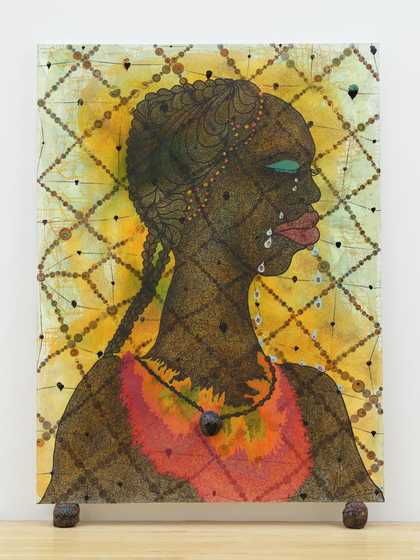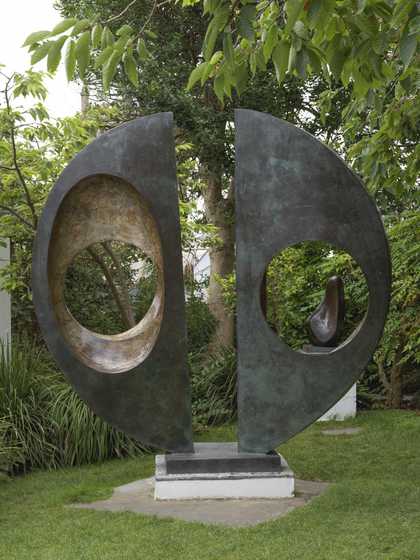Everything Else has Failed! Don't you Think it's Time for Love? is an installation by the American artist Sharon Hayes.
Five loudspeakers arranged in a row in the centre of the room face five differently coloured A2 graphic posters also hung in a row on the wall.
The loudspeakers and the images are installed facing each other as though they are in dialogue with one another. The loudspeakers are mounted approximately one and a half metres from the floor on black stands. In sequence, each loudspeaker plays one of five audio recordings of spoken word performances by the artist.
The room is filled with the recorded sound of the artist's voice, the busy ambience of the city and pedestrians passing by.
[Recorded voice]: It feels like an eternity since we've seen each other, since I heard your voice deep inside my head
The artist has described the speakers as installed like a line of speaking bodies. The five A2 prints are portrait-orientated and hung at the same height as the loudspeakers. They are spray painted in the flat graphic style of DIY activist posters and mounted in modest thin black frames.
Each print has two vivid contrasting colours, one for the background and the other for the text and image on top. The title of the artwork printed in a bold headline font fills the top half of each print, a smaller text in the lower left half of each print advertises the date and location of the performance.
On the right side of each print there's a single silhouette of the artist standing with a microphone on a stand.
In each print her stance and direction are slightly varied From left to right the colours of the five prints are pink with red, yellow with white yellow with orange, brown with beige and light blue with dark blue.
The audio recordings are of a series of performances the artist made in 2007 over five consecutive lunch times.
The artist recited letters to unnamed lovers into an amplified microphone on the street outside a UBS investment bank in Manhattan.
[Recorded voice]: I started I started making scratch marks on the wood in the door jamb of the... between my my bedroom and my living room a mark for every day that you're gone but the days are so long and I'm not quite sure what to do with the day anymore except listen to the news and the news is so bad that somehow I found myself marking bombs instead of days and so now from my door jamb it seems like we've been apart for a half a year and every mark seems like it's a possible strike against you but at least I know that if I find out many months from now that you were hurt or you were killed in September at least I know I was with you when it happened
The letters are highly emotional and intimate fraught with despair desire and longing. She speaks about her sense of helplessness during the unfolding invasion and occupation of Iraq and Afghanistan, the trauma and dislocation of living in a moment of war as a U.S. citizen and feeling dislocated from her daily life.
She narrates intimate details of her relationships with lovers through conversations and moments together, separations and distances.
Aspects of these personal relationships begin to echo and reflect the intensely conflicted feelings she holds towards these broader political narratives.
The title for this work was taken from a sign held by a protester in Berkeley in 1967.
It is the first in a series of works she has called Love Addresses.
These were made amidst a despairing feeling that mass street protests were unable to stop the US invasion of Iraq and Afghanistan.
The Love Addresses draw on archival material particularly slogans and placards from various liberation protests in the U.S such as Stonewall era gay rights protests where love functioned as a political tool. Hayes became involved with the performance scene in New York In 1991 in the middle of the AIDS crisis. She has said this directly influenced her understanding that most aspects of our lives as queer people are political.
[Recorded voice]: People always say that in the moment of crisis the path of wisdom is far better than the path of emotion. At a point in every person's life one has to look deeply into the mirror of one's soul and decide one's unique truth in the world, not the way one wants it or the way one hopes it but the way it is and so my truth is that I am a gay American. This is an intensely personal decision, one not typically meant for the public domain but we shall not and cannot let it pass, I march in the parade of freedom but as long as I love you I am not free.
In the letters she addresses her lovers directly as 'you' but there is nothing explicit in the text or installation to identify them. As listeners we can feel as though we could be directly addressed by these words.
The artist has described "trying to reach someone specific by shouting into the wind so to speak".
The letters do not specify the sexuality or gender of the writer or lover but Hayes has said "I butched myself up even more than usual because I didn't want the love to be read as heteronormative".
There is a contrast between the visual restraint of the materials in the installation and the emotionally evocative recital of the letters.
Hayes has said in relation to her work "What if we were focused as much on hearing and speaking as on seeing?"
This audio description was written and recorded by Chris Timms




